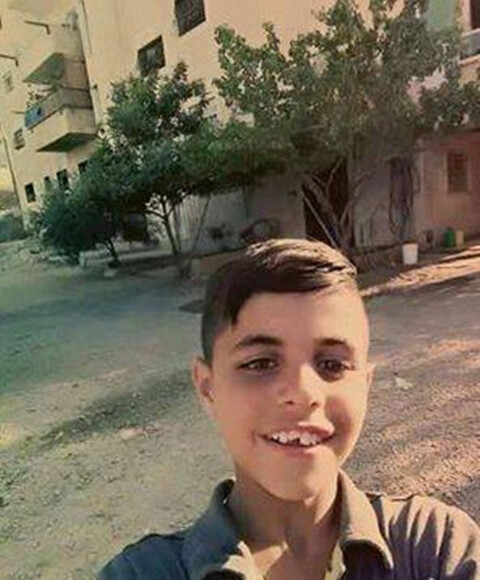The Electronic Intifada 3 August 2016

Palestinian women cross through the Qalandiya military checkpoint in the occupied West Bank, where the Israeli military controls movement between Jerusalem and Ramallah, as they head to al-Aqsa mosque in Jerusalem to pray on the last Friday of Ramadan, 1 July.
ActiveStillsIsraeli forces killed six Palestinians in the occupied West Bank during the month of July.
Both Muhyee al-Tibakhi, 10, and Anwar al-Salaymeh, 22, were killed by occupation soldiers in the West Bank town of al-Ram near Jerusalem.
On 19 July al-Tibakhi was killed by a sponge round fired by soldiers towards a small group of children throwing stones at them in the area of the town where Israel is building a concrete wall. The boy is the 26th Palestinian child to be killed in the West Bank and Gaza Strip since the beginning of the year.
Al-Salaymeh was killed on 13 July when soldiers opened fire on his car; one of two passengers in the vehicle was injured.
Israel claimed that its Border Police combatants feared al-Salaymeh was trying to run them over, but the human rights group B’Tselem said that “eyewitness testimony and statements by the passengers in the car – later confirmed by security camera footage – raises serious concern that the lethal gunfire was entirely unjustified.”
Apparent extrajudicial killing
Israeli forces apparently extrajudicially executed Muhammad al-Faqih, who its intelligence agency claims carried out a shooting near Hebron earlier in the month that caused the crash of a car, killing an Israeli settler and injuring his wife.
Israeli forces besieged a home in which al-Faqih was hiding in the Hebron-area village of Surif on 27 July, firing on it with small arms and missiles, then using construction machinery to destroy most of the house while al-Faqih was inside after he refused to surrender.
Another three Palestinians, Mustafa Baradiya, 51; Sarah Tarayra, 27; and Rami Muhammad Zaim Awartani, 31, died of injuries sustained during what Israel alleges were attacks on soldiers.
Awartini was shot and killed after allegedly running towards soldiers while carrying a knife at the Huwwara military checkpoint near the northern West Bank city of Nablus on 31 July. No Israelis were reported injured during the incident.
Baradiya was fatally wounded outside al-Arroub refugee camp near Hebron on 18 July after he allegedly lightly injured two Israeli soldiers by stabbing them with a screwdriver. His brother was shot dead in the same location three months earlier after he allegedly attempted to hit a soldier in the head with an ax. No Israelis were injured during that incident.
Tarayra was shot and killed on 1 July near the Ibrahimi mosque in the Old City of Hebron, the site of several other deadly incidents since a new phase of violence began last October. Israeli police claimed that the woman was killed after attempting to stab soldiers at a checkpoint. No Israelis were reported injured during the incident.
Israel froze tens of thousands of entry permits and imposed sweeping closure and other movement restrictions on the Hebron area following multiple deadly attacks on Israelis in the area on 30 June and 1 July.
The closure significantly disrupted “the access of some 400,000 Palestinians to services and livelihoods,” the United Nations monitoring group OCHA stated.
UN Secretary-General Ban Ki-moon said on 12 July that “closures – such as those in Hebron – as well as punitive demolitions and blanket revocations of permits penalize thousands of innocent Palestinians and amount to collective punishment.”
A 63-year-old Palestinian man died after he suffered excessive tear gas inhalation on 1 July after Israeli forces fired on a crowd of Palestinians attempting to cross the Qalandiya checkpoint, where the Israeli military controls movement between the West Bank cities of Jerusalem and Ramallah, to pray at Jerusalem’s al-Aqsa mosque on the last Friday of Ramadan.
Gazans die of injuries
In Gaza, Nael Suleiman Salah, a 19-year-old fighter with the Qassam Brigades, Hamas’ armed wing, died of his injuries sustained when he was shot in the head by Israeli soldiers in May 2015. An Israeli army spokesperson said at the time that Salah was the “main instigator” of a group trying to breach the fence along Gaza’s boundary with Israel.
Another Palestinian in Gaza, Hadiya Abu Shammala, died of injuries sustained 15 years earlier when she was shot in the head by Israeli forces as she was traveling with other family members in a taxi that took a wrong turn near the Rafah crossing leading to Egypt.
The taxi driver “immediately pulled over and made a U-turn, but Israeli soldiers stationed near the crossing opened fire at the vehicle, injuring the driver along with Abu Shammala, then 53 years old, and two other young women,” according to the Ma’an News Agency.
On 31 July, skeletal remains were found under the rubble of a home in the Shujaiya neighborhood of Gaza City which was razed during a ground incursion during Israel’s 51-day onslaught in summer 2014.
Also in Gaza, two Palestinian fighters with the armed wing of Islamic Jihad died in separate tunnel collapses.
Rocket fire and airstrikes
On 1 July, a Palestinian armed group fired a rocket at the Israeli town of Sderot, damaging a building; the following day the Israeli army carried out a series of airstrikes “targeting sites reportedly belonging to Palestinian armed groups,” injuring two people and causing property damage, according to OCHA.
The Egyptian-controlled Rafah crossing, the sole point of exit and entry to the vast majority of Gaza’s nearly 1.9 million residents, was exceptionally opened for travel in both directions on 2-4 July, allowing nearly 3,000 people to exit and 1,600 to enter Gaza. More than 30,000 people are registered and waiting to cross, among them medical patients needing treatment unavailable in Gaza.
Gaza’s sole power plant was forced to shut down one of its two operating turbines on 14 July “due to a shortage of fuel, triggering rolling power cuts of 18-20 hours per day, up from 16-18 hours previously,” OCHA reported.
“This has had a significant impact on the provision of basic services, water supply and health in particular. The fuel shortage is reportedly attributed to the continuing disputes between the Ramallah and Gaza authorities over a tax exemption for the fuel purchased for the plant,” OCHA added.
Meanwhile in Syria, Yaser Mahmoud Shuaib, a Palestinian refugee and worker with UNRWA, the UN agency for Palestine refugees, was killed in Aleppo on 17 July when he was struck by shrapnel fragments in his back.
Several people, including a 16-year-old boy and a baby girl, were reported to have been killed and more were injured in Khan Eshieh refugee camp near Damascus during multiple Russian and Syrian government airstrikes and by sniper fire throughout the month.
More than two dozen Palestinians died as a result of the ongoing violence in the country during July, according to the Action Group for Palestinians of Syria.
Editor’s note: an earlier version of this story stated that five Palestinians were killed in the West Bank during July. It has been corrected to state that six were killed and details of the killing of Rami Muhammad Zaim Awartani have been added.

A Palestinian man prepares salted fish to be sold at a market ahead of the Eid al-Fitr holiday marking the end of Ramadan, Khan Younis, southern Gaza Strip, 3 July.
APA images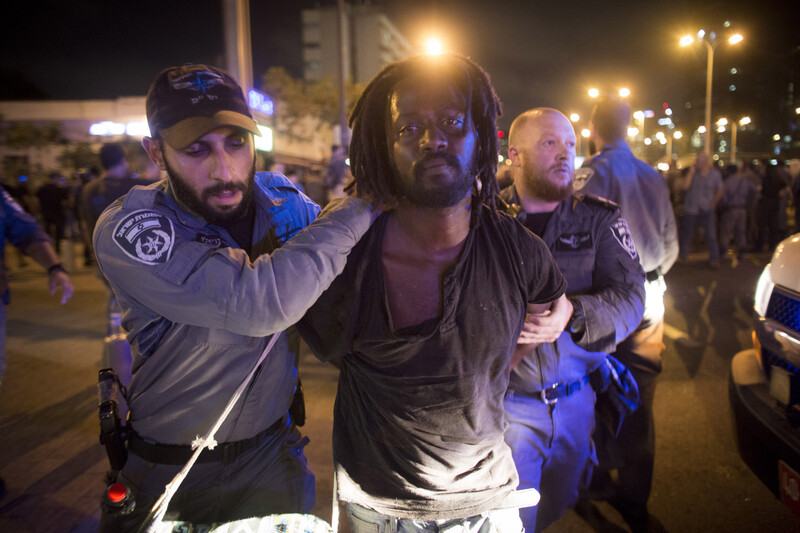
Policemen arrest a demonstrator as Ethiopian citizens of Israel protest against police violence and racism in central Tel Aviv, 4 July.
ActiveStills
Palestinian youths from occupied East Jerusalem play on the beach along Tel Aviv and Jaffa on 7 July, the second day of Eid al-Fitr. Israel canceled tens of thousands of permits for Palestinians from the West Bank to enter Israel to visit their families for the holiday as a collective punishment measure following attacks against Israelis in Tel Aviv and in the West Bank.
ActiveStills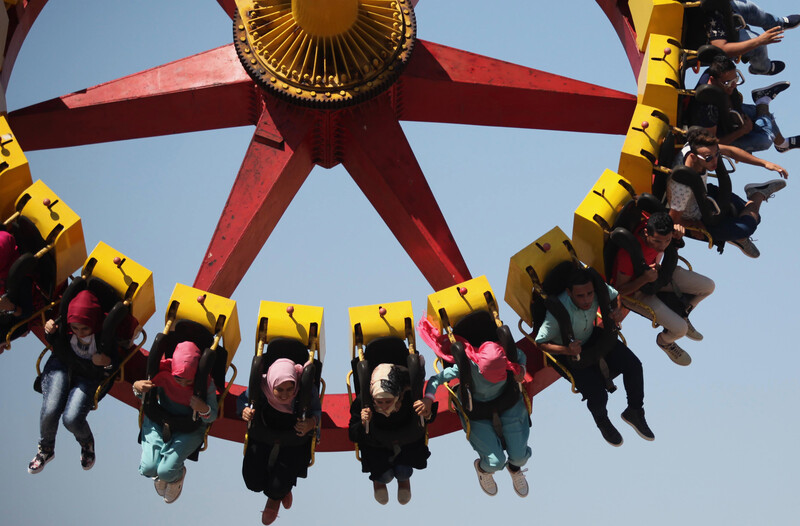
Palestinian youths enjoy an amusement park ride in Gaza City on 8 July, the third day of the Eid al-Fitr holiday marking the end of Ramadan.
APA images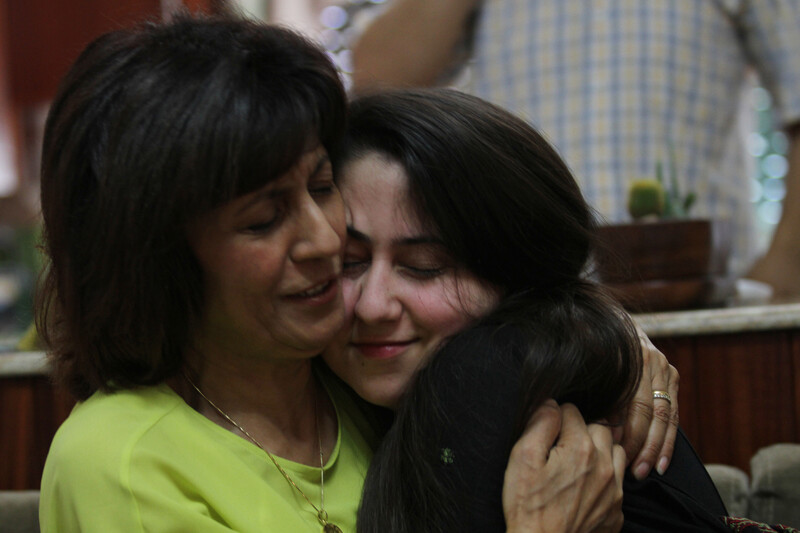
High school student Yasmin Murad Suleiman celebrates with her family in the West Bank city of Nablus after it was announced that she had scored 99.4 out of 100 on the tawjihi final exams, 11 July.
APA images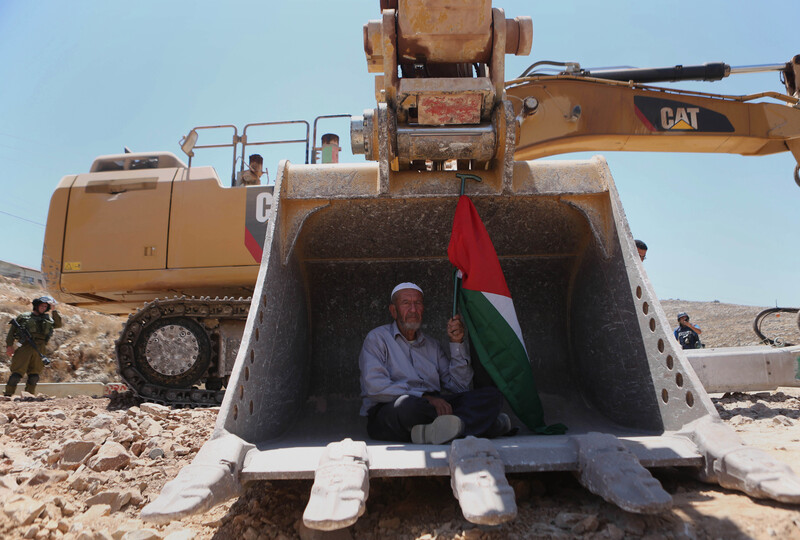
A man holding a Palestinian flag sits in the scoop of an Israeli excavator as he tries to prevent it from clearing his land during a protest against Jewish settlements near the Ramallah-area village of Deir Qaddis in the West Bank, 13 July.
APA images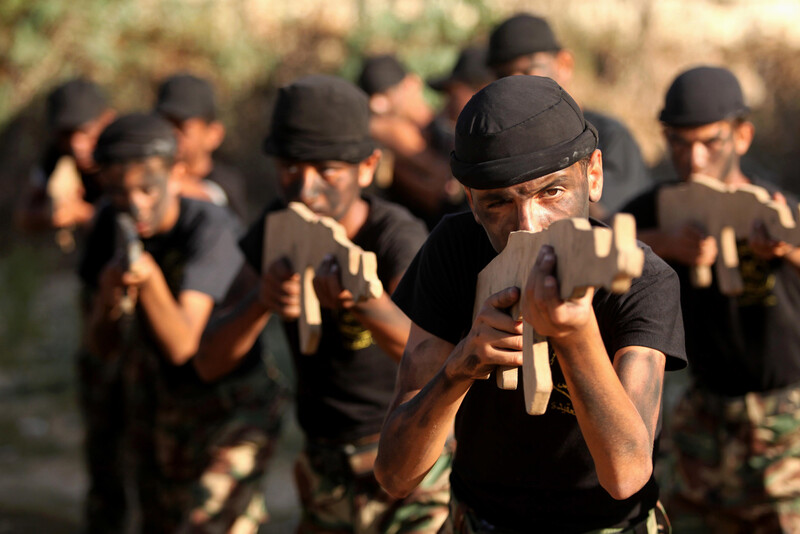
Palestinian youths take part in a military-style graduation ceremony at a summer camp organized by the Islamic Jihad resistance group in Khan Younis, southern Gaza Strip, 15 July.
APA images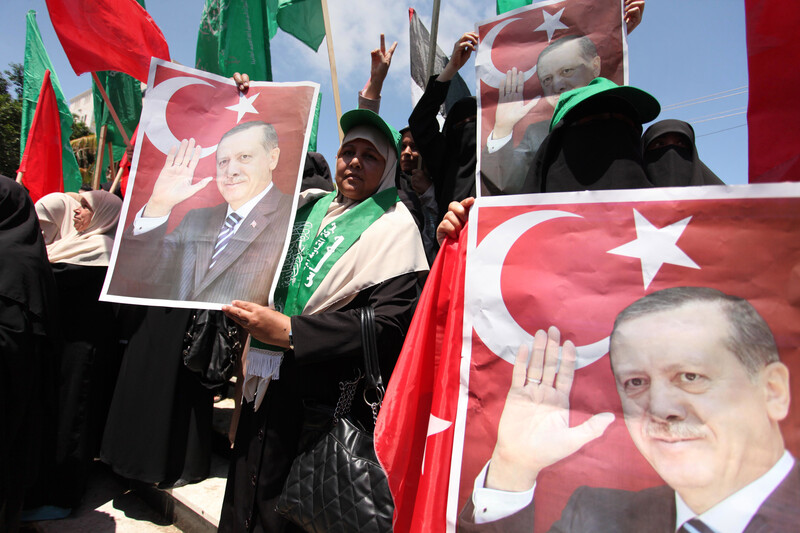
Hamas supporters in Gaza City hold portraits of Turkish president Recep Tayyip Erdogan as they protest the military coup attempt in Turkey, 17 July. In June, Turkey and Israel normalized relations after years of deep freeze following the deadly raid on the Turkish-owned Mavi Marmara as it sailed in international waters as part of a flotilla to break the siege on Gaza in May 2010. Turkey had conditioned reconciliation on an end to the siege, but that demand was dropped and in a face-saving measure, Israel will allow Turkey to increase its humanitarian projects in the territory.
APA images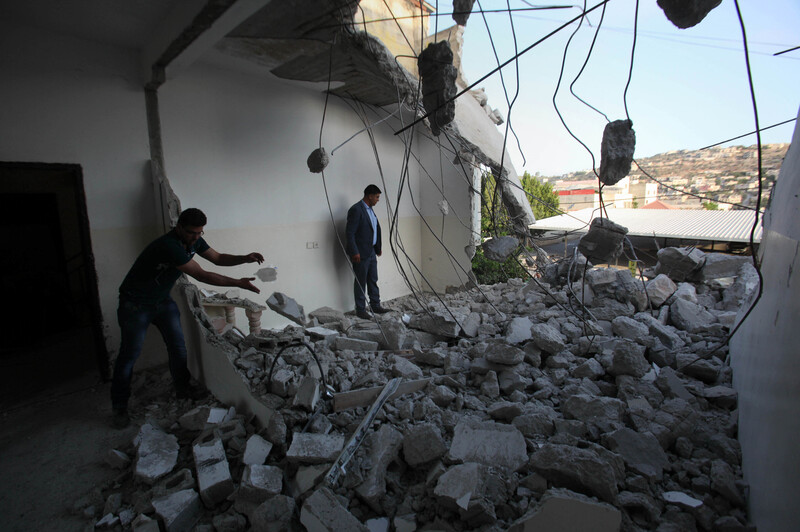
A man stands in the rubble of a home destroyed by Israeli forces in the village of Qabatiya, near the West Bank city of Jenin, 18 July. The home belongs to the family of a Palestinian youth who was among a group of three from the village who were shot dead when they opened fire on Israeli police in Jerusalem in February, killing one.
APA images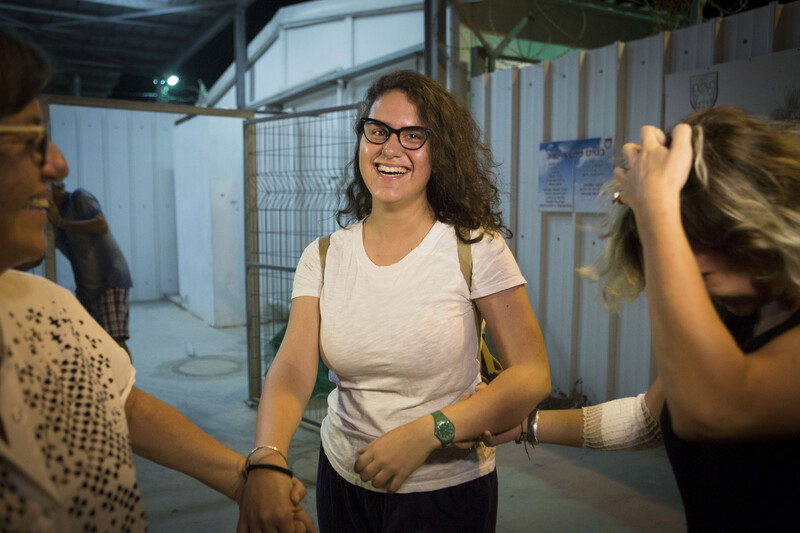
Conscientious objector Tair Kaminer is greeted by her family following her release from military prison near the Israeli town of Atlit on 19 July. Kaminer spent 159 days in military prison for refusing to serve in the Israeli army in protest of the occupation of the West Bank and Gaza Strip.
ActiveStills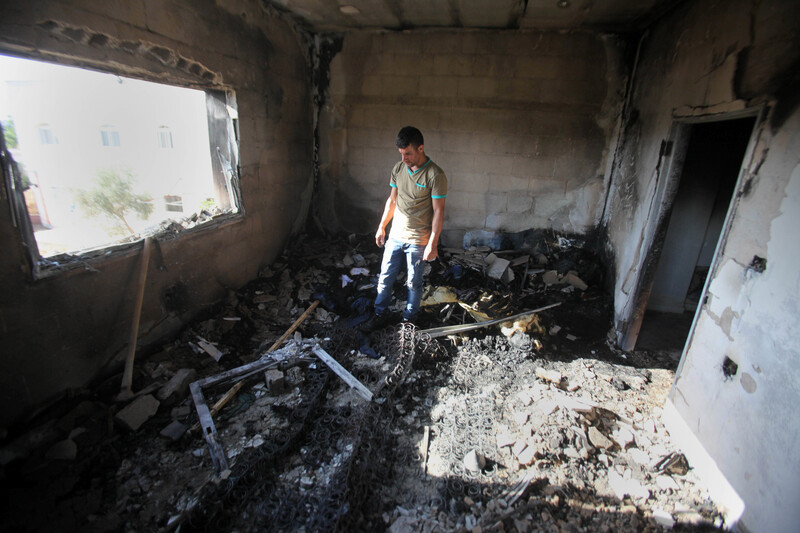
A Palestinian man inspects a damaged home following a fire overnight in the West Bank village of Duma, 20 July. Village residents and Palestinian officials suspected an attack by Jewish extremists — a baby and his parents were killed in an arson attack by extremists in Duma one year prior — but Israeli police said they did not find evidence of an attack.
APA images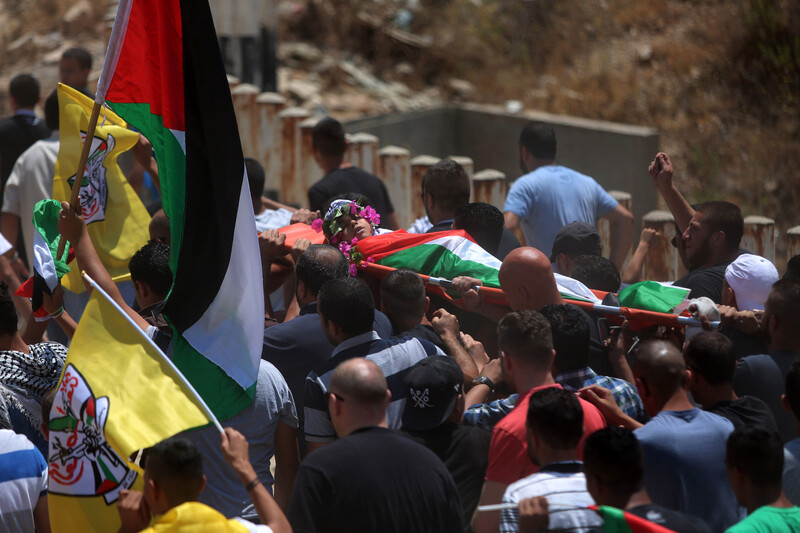
Palestinians carry the body of Muhyee al-Tibakhi, 10, who was killed by Israeli forces in the West Bank town of al-Ram, during his 20 July funeral.
APA images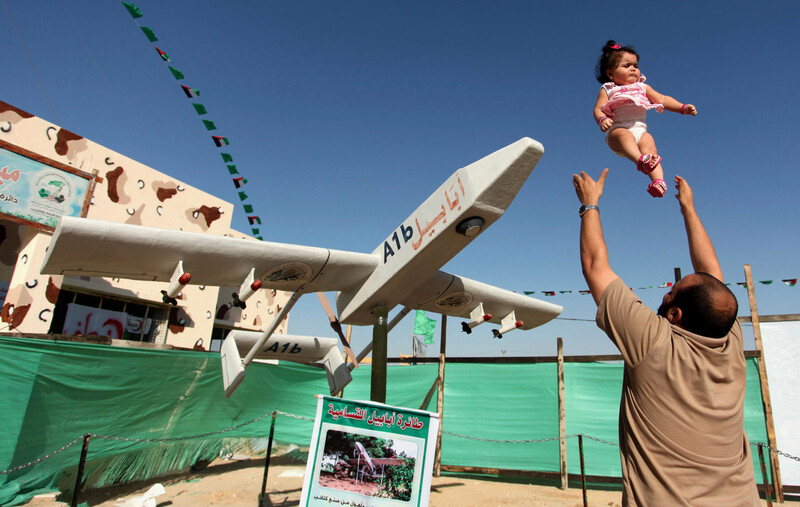
A Palestinian man plays with his daughter next to a model of the “Ababil” drone developed by Hamas during a weapons exhibition at a youth summer camp organized by the political party and resistance group in Gaza City, 21 July.
APA images
A Palestinian boy observes a ransacked room after Israeli forces raided a family’s home in Kufr Qalil near the West Bank city of Nablus, 21 July.
APA images
A Palestinian protester throws stones towards an Israeli military vehicle spraying “skunk” water — a foul-smelling liquid — in Kufr Qaddum, near the West Bank city of Nablus, during confrontations following the weekly demonstration against Israel’s expropriation of village land, 22 July.
APA images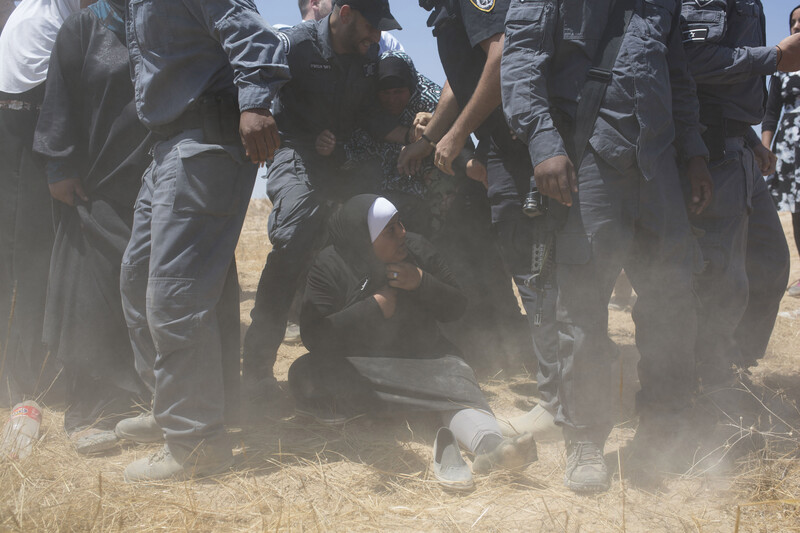
Israeli police arrest youths in the village of al-Araqib in the Naqab desert in the south of present-day Israel as residents of the Bedouin village, not recognized by the government, block bulldozers used by the Jewish National Fund to plow private lands belonging to villagers, 24 July. The Jewish National Fund is planting a forest on the village’s lands as the government repeatedly demolishes structures in the village.
ActiveStills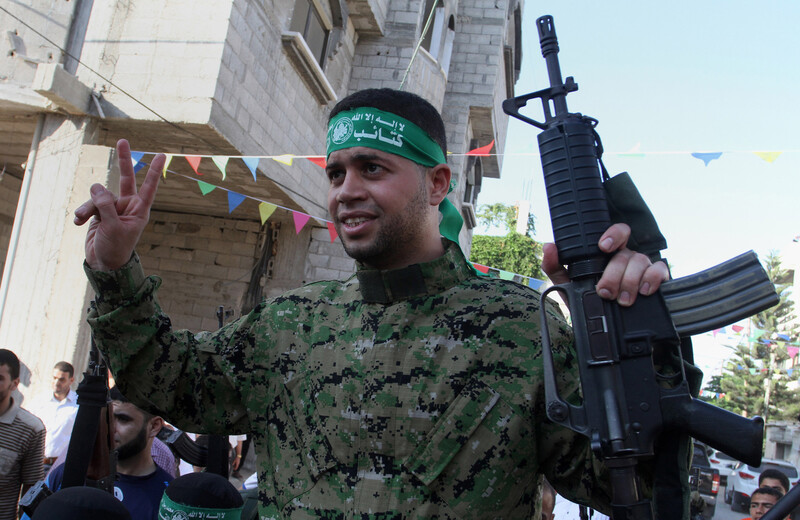
Muhammad al-Bashiti, who served 12 years in an Israeli prison after he was convicted for membership in Hamas’ military wing, waves as he is greeted upon returning home after his release from prison, Rafah, southern Gaza Strip, 25 July.
APA images
Palestinian girls play during a summer camp in Gaza City organized by UNRWA, the United Nations agency for Palestine refugees, on 25 July.
APA images
Palestinians inspect the site where Israeli forces besieged and killed Muhammad al-Faqih during a raid on a home in which al-Faqih was hiding in the West Bank village of Surif, near Hebron, 27 July. Most of the home was demolished during the raid. Israel claimed that al-Faqih carried out a shooting near Hebron earlier in the month that caused the crash of a car, killing an Israeli settler and injuring his wife.
APA images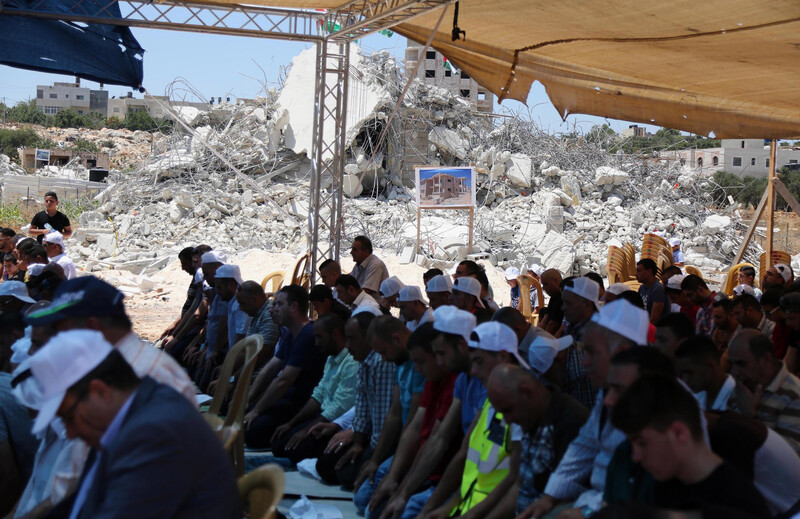
Palestinians observe Friday prayers next to the rubble of homes destroyed by Israeli forces three days earlier in the West Bank village of Qalandiya, 29 July. Israel claimed the homes were built too close to its massive concrete wall and were built without permits. Several Palestinians, including a journalist, were injured when confrontations broke out during the demolition raid, the Ma’an News Agency reported.
APA images
